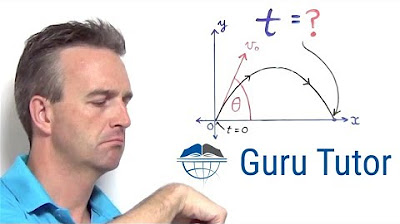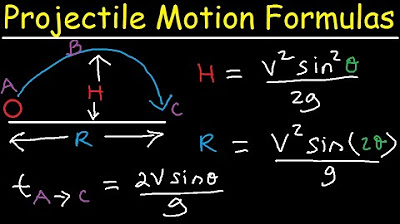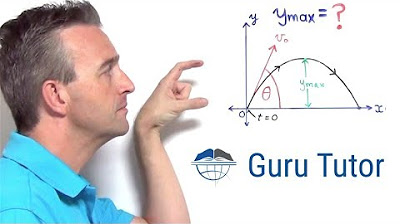Physics 3.5: Projectile Motion - Finding the Angle (3 of 4) Different Height
TLDRThe video script presents a comprehensive guide to calculating the launch angle required for a projectile to travel a certain distance when the initial and final heights differ. It explains the process of finding the time of flight in both the x and y directions, and how to eliminate the time variable to solve for the angle. The script introduces a more complex scenario than previous examples, involving different initial and final heights, and uses trigonometric functions and algebraic manipulations, including the double angle formula, to derive a final equation for the angle. The detailed walkthrough helps viewers understand the mathematical principles behind projectile motion with varying heights.
Takeaways
- 🎯 The general solution for finding the angle required for a projectile to reach a certain distance with different initial and final heights is discussed.
- 🚀 Initial velocity in both the x and y directions is necessary for the calculation, which can be determined from the angle and the initial velocity magnitude.
- 🧮 Time of flight for both directions is calculated using the respective kinematic equations, with no acceleration in the x direction due to the absence of gravitational force.
- 🌐 The problem is solved by eliminating the variable time (T) and rearranging the equation to solve for the angle of projection.
- 🔄 The process involves substituting expressions for the initial velocities in terms of the angle and simplifying the resulting equation.
- 📈 A substitution is made to simplify the equation further, introducing a constant 'a' which is derived from the given parameters.
- 🔢 The double angle formula is used to rewrite the equation in a more manageable form, facilitating the isolation of the angle variable.
- 🤹 The equation is transformed into a single trigonometric function, which can be expressed as R times the sine of an angle minus a phase angle.
- 🛠️ The final form of the equation allows for the calculation of the unknown angle using the arc cosine function and the derived expressions.
- 📊 The solution requires algebraic manipulation and understanding of trigonometric identities to isolate and solve for the angle of projection.
- 🎓 The process is complex and requires a solid understanding of projectile motion and the application of kinematic equations.
Q & A
What is the main topic of the video?
-The main topic of the video is finding the angle required for a projectile to reach a certain distance when the initial and final heights are different.
How is the general solution for the projectile motion different when the initial and final heights differ?
-The general solution involves finding the initial velocity in both the x and y directions, calculating the time of flight for both directions, and then solving a set of equations that include the initial height (H), the horizontal distance (x), and the final height (which is zero in this case).
What are the equations used to calculate the time of flight in the x and y directions?
-For the y direction, the equation used is y = y0 + v0y * t - 0.5 * g * t^2. For the x direction, since there is no acceleration, the equation simplifies to x = v0x * t, where v0x is the initial velocity in the x direction.
How is the variable T eliminated from the equations to find the angle?
-The variable T is eliminated by expressing v0x in terms of the angle (θ) and then substituting it into the equation for the y direction. This allows the equation to be solved for θ without the need for T.
What is the significance of the substitution a = (g * x^2) / (2 * v0n^2) in the equations?
-The substitution simplifies the equation and makes it easier to work with by eliminating the cosine term in the denominator and allowing the equation to be rewritten in terms of a single trigonometric function.
How is the double angle formula used in solving for the angle?
-The double angle formula is used to rewrite sin^2(θ) as 1 - cos(2θ), which helps to eliminate the cosine term and further simplify the equation to solve for θ.
What is the final form of the equation used to find the angle θ?
-The final form of the equation to find θ is 2θ - V = arccos((2 * a - H) / (sqrt(H^2 + x^2))), where a = (g * x^2) / (2 * v0n^2) and V is determined by the specific problem's details.
What is the practical application of finding the angle in projectile motion?
-Finding the angle in projectile motion is important in various real-world scenarios such as sports, physics experiments, engineering projects, and any situation where predicting the trajectory of an object is necessary.
How does the negative acceleration due to gravity (g) affect the projectile motion equations?
-The negative acceleration due to gravity (g) affects the projectile motion equations by causing a downward acceleration in the y direction, which is why it is typically negative in the equations. In the x direction, there is no effect from gravity, so the acceleration is zero.
What is the role of initial velocity components in the projectile motion equations?
-The initial velocity components (v0x and v0y) are crucial in the projectile motion equations as they determine the object's speed in the x and y directions. These components are used to calculate the time of flight and the distance traveled by the projectile.
Why is it necessary to solve for the angle in projectile motion problems?
-Solving for the angle in projectile motion problems is necessary to determine the optimal launch angle that will result in the desired trajectory, such as reaching a target at a certain distance or achieving maximum range.
Outlines
🚀Projectile Motion: Finding the Launch Angle with Different Initial and Final Heights
This paragraph introduces the concept of projectile motion where the initial and final heights are different. It explains the need to find the angle required for a projectile to reach a certain distance, given the initial velocity in both the x and y directions. The paragraph details the process of calculating the time in the air for both directions and the method to eliminate the variable T to solve for the angle. It also discusses the changes in the equations due to different initial heights and the approach to solving the problem, including the substitution of variables and the use of gravitational acceleration (G).
🧮Solving the Equation: Simplification and Trigonometric Identities
The second paragraph delves into the simplification of the equation derived in the first part. It describes the substitution of a constant (a) to make the equation cleaner and the use of double angle equations to eliminate the cosine term. The paragraph outlines the process of multiplying out the terms, combining constants, and isolating the angle Theta. It also explains the concept of rewriting the equation as a single trigonometric function and the steps to achieve this, including the use of trigonometric identities and the final form of the equation to solve for the unknown angle.
🎓Advanced Trigonometry: Solving for the Launch Angle
The final paragraph focuses on the advanced trigonometric techniques required to solve for the launch angle in the projectile motion problem. It explains the process of combining sine and cosine functions into a single trigonometric function and the use of the inverse cosine function to find the angle. The paragraph details the steps to isolate the phase angle and the method to solve for the launch angle using the derived equation. It emphasizes the complexity of the process and the importance of understanding the underlying mathematical principles to arrive at the solution.
Mindmap
Keywords
💡Projectile Motion
💡Initial Velocity
💡Angle of Projection
💡Trajectory
💡Gravity
💡Time of Flight
💡Acceleration
💡Equations of Motion
💡Trigonometry
💡Double Angle Identity
💡Arc Cosine
Highlights
The general solution for finding the angle required for a projectile to reach a certain distance when the initial and final heights are different.
The need for the initial velocity in both the y and x directions to calculate the projectile's trajectory.
The timing in the air for both x and y directions is crucial for solving the problem.
The equation for time in the air for the y direction, incorporating gravity's acceleration.
The absence of acceleration in the x direction due to the lack of gravitational force.
The elimination of the variable T by solving the equation for the initial velocity in the x direction.
The substitution of the initial velocity in the y direction based on the projectile's angle.
The final height being zero, but the initial height being H, which modifies the equation.
The positive value of G in the projectile motion, despite it typically being negative.
The substitution process leading to a cleaner equation involving the angle's sine and cosine.
The use of double angle equations to simplify and rewrite the equation without the cosine term.
The final form of the equation that allows for the calculation of the unknown angle.
The method for isolating the angle and the use of trigonometric functions to solve for it.
The detailed algebraic manipulation and the final equation for finding the projectile's launch angle.
Transcripts
Browse More Related Video

Projectile Motion Time of Flight Formula Derivation

Where Does The Range Equation Come From?

Introduction to Projectile Motion - Formulas and Equations

Time of Flight in Projectile Motion | Physics

No Calculus Needed?! How to Maximize Range Using Simple Geometry.

Projectile Motion Maximum Height Formula Derivation
5.0 / 5 (0 votes)
Thanks for rating: